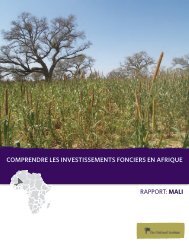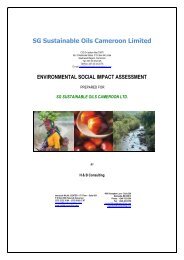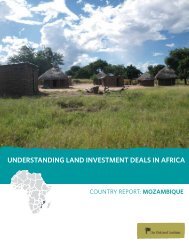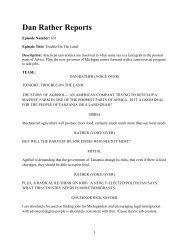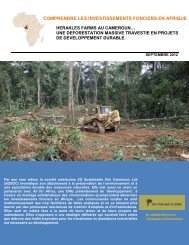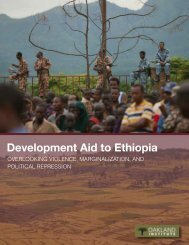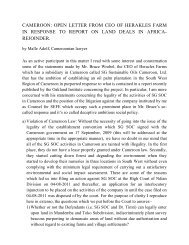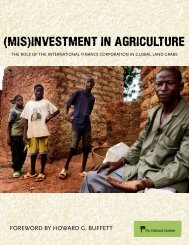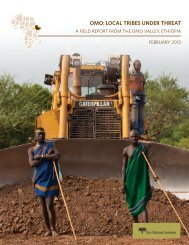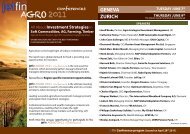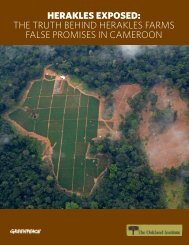Zambia - Oakland Institute
Zambia - Oakland Institute
Zambia - Oakland Institute
Create successful ePaper yourself
Turn your PDF publications into a flip-book with our unique Google optimized e-Paper software.
BOX 11: ZAMBIA’S ENVIRONMENTAL<br />
LEGISLATION<br />
• Environmental Protection and Pollution<br />
Control Act (1990)<br />
• Water Pollution Control Regulations(Stat<br />
#72 of 1993)<br />
• Pesticides and Toxic Substances Regulations<br />
(1994)(#20, 1994)<br />
• Water Act (1996)<br />
• Wildlife Act (1998): Enables Game<br />
Management Areas (GMA)<br />
International Agreements<br />
• Convention on Biological Diversity (CBD)<br />
• Ramsar Convention on Wetlands<br />
• UNF Convention on Climate Change<br />
• African Convention on the Conservation of<br />
Nature and Natural Resources<br />
Game parks and wildlife viewing and hunting provides<br />
an invaluable source of revenue for government and<br />
local businesses alike. Generally speaking wildlife and<br />
large-scale agriculture are not compatible. There are<br />
many cases of conflict between elephants and farmers<br />
(elephants destroy crops). In the short term, it should<br />
be possible for large farms to avoid critical wildlife<br />
habitat, but as more and more land is converted to<br />
agriculture, this conflict will become unavoidable. The<br />
lack of involvement of stakeholders and government<br />
departments with mandates for environmental/wildlife<br />
issues in combination with the reduction of regulations<br />
could lead to a situation in which wildlife populations,<br />
critical habitats, and protected areas will not be spared<br />
the devastations associated with agricultural land<br />
clearing.<br />
ENVIRONMENTAL IMPACT ASSESSMENT<br />
Environmental Impact Assessment (EIA) in <strong>Zambia</strong><br />
is still largely in its infancy. While the EIAs that were<br />
viewed were generally up to international standards, the<br />
lack of transparency and consultation, and their limited<br />
implementation restrict their use as a tool that could<br />
lead to more sustainable agriculture developments in<br />
<strong>Zambia</strong>.<br />
As per the EIA regulations, full EIAs are to be completed<br />
for any development that involves land clearance<br />
for large-scale agriculture, introduction and use of<br />
agrochemicals or crops new to <strong>Zambia</strong>, development<br />
of resettlement schemes, irrigation schemes covering<br />
an area >=50 ha, or aerial and ground spraying. No<br />
definition of what constitutes large-scale agriculture<br />
is available in the EIA regulations, but outgrower<br />
schemes are not subject to EIAs. In addition, any food<br />
processing plant involving more than 400 tons/year<br />
are subject to a full EIA. Any investor who does not<br />
comply with the EIA regulations (including undertaking<br />
an activity without carrying out an EIA) is “liable, upon<br />
conviction, to a fine not exceeding ZMK one hundred<br />
thousand (USD 20) or to imprisonment for a period<br />
not exceeding three years or to both.”<br />
The end product is a letter of approval that outlines<br />
binding terms and conditions (sometimes merely<br />
mitigations identified in an EIA, sometimes with terms<br />
and conditions added by ECZ). According to ECZ, noncompliance<br />
with these terms and conditions results<br />
in termination without notice. The determination of<br />
non-compliance is based largely on inspections and<br />
environmental audits. ECZ told the research team<br />
that agricultural audits are very rare (focus is mainly<br />
on mining), and that the ECZ hardly ever turns down<br />
a project with significant adverse impacts, because<br />
“there is always a mitigation or alternative available<br />
that will allow the project to go ahead.” 159<br />
Copies of the EIA are required to go to local government<br />
and chiefs and all documents created in conjunction<br />
with an assessment are to be publicly available. Yet<br />
research could not find any indication that this happens<br />
in practice. 160 . The research team was only able to<br />
access certain assessments, that were made available<br />
with permission from senior officials with ECZ and<br />
no list of assessments that had been completed was<br />
available.<br />
One report suggests that only 15 percent of listed<br />
agricultural projects had an EIA. 161 Despite ECZ claims<br />
that social impacts such as displacement are assessed,<br />
OI’s research found little evidence to show that they<br />
are undertaken in any meaningful way. The tools are<br />
in place for an effective EIA system but because of a<br />
The <strong>Oakland</strong> <strong>Institute</strong> UNDERSTANDING LAND INVESTMENT DEALS IN AFRICA: ZAMBIA | 48



